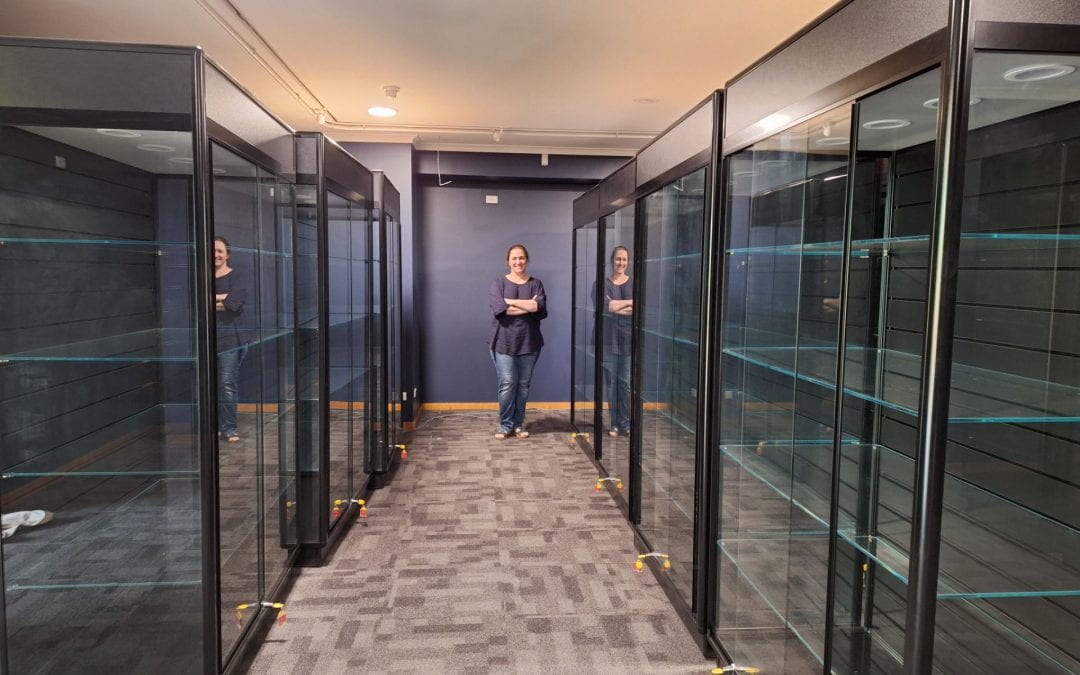Image: Dr Bronwyn Hopwood, UNEMA’s collections manager, with the new cabinets that will house the museum’s artefacts:
UNE’s Museum of Antiquities (UNEMA) is preparing to launch a brand new look and welcome back visitors after a four-year hiatus.
Boasting a unique collection of over 3000 objects, many with national significance, UNEMA was closed through the COVID pandemic and for storm repairs, before a major refurbishment began in early 2024.
The refurb will better showcase the museum’s important classical antiquities collections, like the Stewart collection of Cypriot ceramics, and popular items like an Eqyptian mummy’s foot and gazelle leather sandal, as well as much new material thanks, in part, to COVID.
“People suddenly had time to sort through their private collections and donate material, resulting in a 20 per cent increase in the museum’s collection over the COVID period. These new donations will form some never-before-seen exhibitions once we reopen,” says Bronwyn Hopwood, UNEMA’s collections manager.
On display for the first time will also be the final donation in 2020 of nearly 200 artefacts from long-time supporter Bruce Reuman, a passionate traveller and collector of original handcrafts showcasing disappearing skills in villages across Africa, Asia, and the Americas.
The museum’s huge collection of artefacts, which took more than three months to safely pack down, has been in storage while repairs and the refurbishment have been underway, and are being prepared for exhibition largely by student and research volunteers under the guidance of collections manager Dr Bronwyn Hopwood.
Dr Hopwood says there’s no better hands-on museum experience for the volunteers, who are helping to build the displays from the ground up.
“There are always objects that need their provenance and history checked – every object must be documented as accurately and fully as possible, so there’s a lot of detective work required, such as contacting experts, researching the social environment in which the object was created, understanding what it meant to that society, and working out its value and significance for us today.
“Everything needs identified, relabelled, relocated, cleaned and documented before being displayed. The volunteers learn about the objects, and the collectors through this process. They also learn about public engagement, and how to tell the stories of our objects that are interesting and engaging.
“These are all skills directly applicable in industry and transferable across museums, galleries, libraries, and archives.”
Rather than being crammed into one small exhibition room, UNEMA’s displays will also enliven the foyer and nearby corridors of the Arts Building.
“One of the exciting new developments is that there will nine cabinets to host temporary exhibitions right out the front of the old museum space, so there will always be something new to greet visitors,” Dr Hopwood says.
The permanent displays will also offer new experiences for visitors.
“We’re currently creating a new and interactive ‘automata’ display which will tell the story of self-moving devices – from the mythical to the real, and from antiquity to the modern world, like clockmaking to industrialisation, to 3D printing. There will also be a 19th century exhibition and a new ‘Masquerade Parade’ gallery exhibiting masks from different world cultures, as well as audioguides to help people better understand the collections and displays.”
“The new displays will vastly improve access to our traditional collection – as the artefacts will be easier to view, better labelled, and easier to extract to handle for research, while the new exhibitions and interactive features will add to the traditional museum experience. UNEMA will offer something of interest for everyone.”
The refurbished museum is expected to launch in mid-2024.



Recent Comments